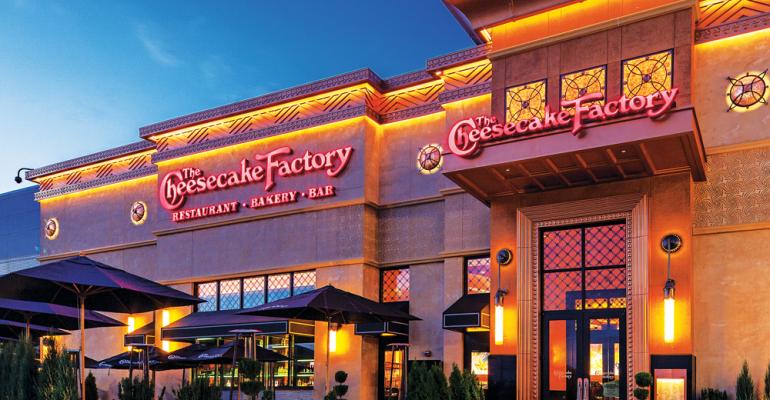 This is part of the Nation’s Restaurant News annual Top 100 report, a proprietary ranking of the foodservice industry’s largest restaurant chains and parent companies.
This is part of the Nation’s Restaurant News annual Top 100 report, a proprietary ranking of the foodservice industry’s largest restaurant chains and parent companies.
Dave & Buster’s Entertainment Inc. has found a way for a Casual-Dining chain to generate higher sales: Be less of a restaurant and be more of an amusement park.
The 90 units the company operated in its Latest Year, up from 80 the Preceding Year, are 30,000-square-foot palaces devoted to games and sports and, oh yeah, a little food.
The result is an industry-leading Estimated Sales Per Unit of $11.7 million.
What’s more, that number is growing. ESPU grew 3.6 percent in the Latest Year, and 4.9 percent the year before that. At a time when consumers have been abandoning dine-in chains, they’ve been flocking to Dave & Buster’s in amazing numbers.
“Once guests are in our stores, we want to sell them the complete experience, including our food and beverage offerings,” CEO Stephen King said on the company’s earnings call this month.
Consumers have been shying away from Casual-Dining chains for more than a decade, a downturn that has taken a turn for the worst more recently amid a challenging market for the industry.
Despite the growth at Dave & Buster’s, for instance, Casual-Dining chains’ average rate of ESPU growth was negative, down 1.5 percent in the Latest Year. In the Preceding Year, the Casual-Dining segment had the lowest average ESPU growth, 0.8 percent, of any Top 100 segment.
Chains that can offer experiences to their consumers are the exception. Right behind Dave & Buster’s on our ranking is Cheesecake Factory Inc., where ESPU was $10.9 million — up 3.8 percent from the Preceding Year. Cheesecake and Dave & Buster’s had the best growth performances in sales per unit among Casual-Dining chains on our ranking.
Dave & Buster’s has had a remarkable run in recent years. Revenue at the Dallas-based company has grown by two-thirds since 2013, to just more than $1 billion for its North American operations, according to the company’s financials.
Food is only part of the equation. Just 45 percent of Dave & Buster’s revenue comes from the sale of food and drinks.

The rest of it, 55 percent, comes from those amusements. And those amusements are getting more and more complex. Consider that, late last year, the chain debuted Rock ’Em Sock ’Em Robots — a giant-sized version of the original kids’ toy. Only the 6-inch robots have been replaced by 5-foot versions.
“We lead with amusement,” King added. “It is a point of differentiation for us and is the focus of our advertising.”
Those games are also profitable. Consider that the cost of amusements in the company’s latest fiscal year was $65.4 million, or 11.8 percent of the revenue generated by those amusements.
By comparison, the cost of food and beverages was $114.9 million, or 25.4 percent of foodservice revenue.
“We’re really cognizant of the fact that driving [food and beverage sales] at the expense of amusements would really be a bad trade for us, given the margin differential,” King said.
C-stores increase their sales
Consumers have been spreading their restaurant dollars around, and not just to restaurants. Convenience stores have become strong competitors in the prepared food business, and the Latest Year was no exception.
For the convenience stores on our ranking, estimated sales per unit averaged 3.2 percent growth, adding to the 7.4 percent growth of the Preceding Year. Only bakery/café chains (up 7 percent) and specialty concepts like Panda Express (up 3.3 percent) had better performance from a unit level standpoint.
That includes Wawa, where ESPU grew 5 percent to $2.5 million, following nearly 10 percent ESPU growth the year before. Sales per unit grew 2 percent at Sheetz, to $1.4 million. And they grew 6 percent at Casey’s General Store, to $490,200.
Chick-fil-A. Again.
Every one of the 10 restaurant chains with the largest sales per unit is a Casual-Dining concept, which is to be expected given their larger unit sizes and higher check averages.
And then there’s No. 11, Chick-fil-A, which again has the largest sales per unit of any Limited-Service concept in the Top 100. The Atlanta-based chain’s sales per unit are $3.9 million.
In other words: One Chick-fil-A equals one McDonald’s and one Burger King.
And they’re not open on Sundays.
Contact Jonathan Maze at [email protected]
Follow him on Twitter: @jonathanmaze


